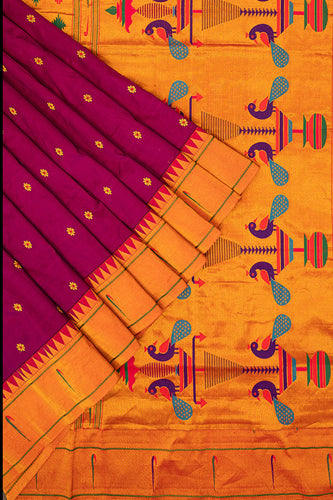How to Identify an Authentic Paithani Saree

Best Ways to Identify an Authentic Paithani Saree
Paithani sarees, known for their luxurious silk and intricate zari work, are a treasured part of India’s textile heritage. However, with their popularity, many replicas have entered the market, making it challenging to distinguish genuine Paithanis from imitations. Here’s a guide to help you identify an authentic Paithani saree.
1. Fabric Quality: Pure Silk
-
Authentic Material: Genuine Paithani sarees are made from high-quality mulberry silk. The fabric feels smooth, soft, and lustrous.
-
Test the Silk: Rub a small section of the saree between your fingers. Real silk feels warm to the touch due to its natural protein structure.
2. Zari Work: Real Gold or Silver Threads
-
Material Check: Original Paithani sarees use real zari threads, traditionally made with gold or silver coating over silk or copper threads.
-
Zari Shine: Authentic zari has a subtle, non-flashy sheen, unlike synthetic zari, which appears overly shiny and metallic.
-
Thread Test: Pull a small zari thread (if permissible) and scrape it gently. Real zari will reveal a reddish or copper core, while fake zari will show a white or plastic base.
3. Signature Motifs
Paithani sarees feature unique, handwoven motifs that are difficult to replicate:
-
Peacocks and Lotuses: These are iconic designs, particularly on the pallu and borders.
-
Narali (Coconut) and Asawali (Creeper): Traditional patterns often woven in intricate detail.
-
Geometric Borders: Authentic Paithanis have symmetrical patterns, such as squares or diamonds, in the borders.
-
Shikargah Motifs: Rare and intricate hunting scenes may also be featured on premium Paithanis.
4. Weaving Technique
-
Handwoven Craftsmanship: Authentic Paithanis are entirely handwoven, resulting in impeccable detailing. Machine-made replicas lack the fine texture and precision of handwoven sarees.
-
Reversible Borders: A hallmark of true Paithani sarees is that the borders look identical on both sides of the saree, with no loose threads visible.
-
No Visible Reverse Threads: In authentic tapestry weaving, the motifs on the pallu do not show any loose threads on the reverse side.
5. Iridescent Effect
-
Kaleidoscopic Colors: Genuine Paithani sarees are known for their shimmering, iridescent effect, achieved by weaving warp and weft threads in contrasting colors.
-
Natural Dyes: Traditional Paithanis use natural dyes that produce vibrant yet soft tones, unlike the synthetic dyes in replicas.
6. Time and Price
-
Time-Intensive Process: Genuine Paithanis take weeks or months to create due to their intricate handwoven designs.
-
Cost: Authentic Paithani sarees are premium products, with prices starting at ₹20,000 and going up to lakhs, depending on the intricacy and materials used. If the price seems too low, it’s likely a replica.
7. Certification and Source
-
Certified Sellers: Purchase from trusted outlets or certified handloom stores that specialize in authentic Paithani sarees.
-
GI Tag: Look for Paithani sarees with a Geographical Indication (GI) tag, which guarantees their authenticity and origin in Maharashtra.
-
Artisan’s Name: Many genuine sellers provide details of the artisan or the workshop, ensuring transparency.
8. The Burn Test (Optional)
-
If permissible, you can test a small thread for authenticity:
-
Silk Test: Burn a small silk thread from the saree. Real silk smells like burnt hair and turns to ash, while synthetic fibers smell like burning plastic and form hard beads.
-
Zari Test: Burn a zari thread. Authentic zari will produce ash due to its metallic content, while fake zari will melt.
Buy Pure Paithani Saree Online at House of Hind
